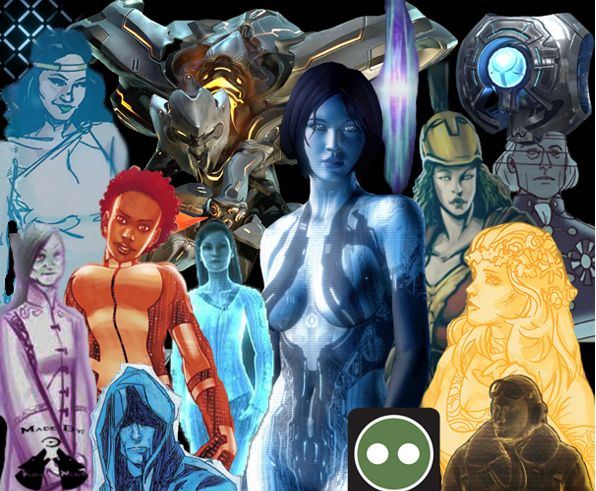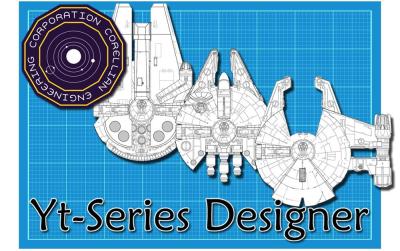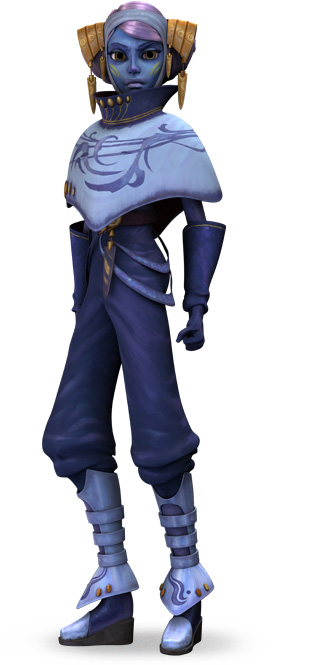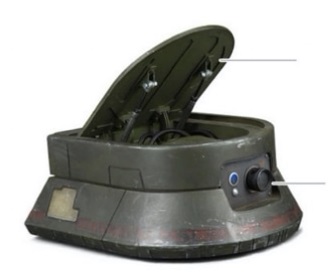 HALO AI CHARACTERS
An artificial intelligence (AI) is an artificial construct that exhibits intelligence similar, and in some categories far superior, to a sapient biological being. AI technology was used by the Forerunners, and was later developed by humanity. According to the Forerunner Technological Tier ranking system, the extensive use of AI is one of the components for sociological and technological advancement. The Covenant also made use of AI technology, but only in its simplest form, as their religious doctrine forbade the creation of more sophisticated thinking machines.
Human AIs include both "smart" and "dumb" varieties. Humanity developed the first-generation "smart" AIs in the mid-21st century. Most human AI constructs give themselves an avatar, a unique visual representation that typically reflects an aspect of the AI's personality or corresponds to its main use.
Attribute Dice:
-Dumb AI: 8D (NPC)
-Smart AI: 12D (PC)
Skill Dice: (in the end, this is up to the GM)
-Dumb AI: GM discretion (Star Wars D6 droid rules)
-Smart AI:
-NPC: 4D-10D
-PC: As player characters.
DEXTERITY N/A
KNOWLEDGE 2D/4D
MECHANICAL 2D/4D
PERCEPTION 2D/4D
STRENGTH N/A
TECHNICAL 2D/4D
Move: N/A
Size: N/A
A NOTE BEFORE READING FURTHER: After writing this up and thinking it was finished, I had some afterthoughts, and thought this was worth adding in. An alternative method of using smart AIs in-game (and this is the method I would prefer) would be to have them just be an extension of a player character. The player now has access to the AI's skills and uses them when needed for those types of actions, using the AI's Attribute and Skill Dice to their fullest when making those rolls. The GM can still act out the role of the AI, but the player makes all the rolls when those skills are needed. The player can even apply their own Character Points and Force/Hero points to these actions if they wish. This is how it can be explained in-game how a smart AI plugged into a Spartan-II's Mjolnir armor can enhance their abilities. If GMs wish, they can even allow the player to kind of "multi-task" and perform an extra action without a penalty to their dice rolls (usually -1D per extra action they take) as long as the extra action is related to the AI's skills. I wanted to add this here so any readers would see it first and know this is how I would prefer using smart AIs in-game. Anything listed below for how to use AIs in-game that deviates from this was left here on purpose as "rules options" for consideration by players/GMs if they prefer them instead.
Character Skills:
-Dumb AI: Given by GM or purchased/programmed by players. If a player(s) make a dumb A.I. use Computer Program/Repair skill to create the base A.I. Start at Moderate Difficulty to create an A.I. with 1D in all Attributes, +1 Difficulty Level for every +1D added to its Attributes. This also assumes the player has access to software and hardware that speeds up and eases the process of making complex computer programs. If not and starting the code from scratch with skill alone, the Difficulty is Difficult and +5 Difficulty for any extra Attribute Dice added in to the A.I.'s creation. NOTE!: Attribute Dice for a dumb A.I. MUST be given at character creation, not afterwards. After its creation, a dumb A.I. can be programmed Skill Dice but not Attribute Dice (GM discretion on whether to wave that). After creation, the player may then program whatever skills they want the A.I. to have, provided they have these skills themselves, access to someone who has these skills, or access to some kind of "A.I. skill coding package" that can be used to add the desired skills to the dumb A.I.
Keep in mind, a dumb A.I. with 1D in it's attributes but with any and all skills you can cram into it, would still be a very useful thing to have around, either for operating a ship's systems as an "autopilot" (but using weapons too?), or physically with you to be plugged into a computer system to hack it for you while you defend it and fight off enemies, or to aid you as you hack the system yourself (Star Wars D6 rules for aiding another, bonus pips!).
-Smart AI: Created as with any other character with starting skill dice, then trained up after character creation. Smart A.I.s can do all the things listed above for dumb ones, but their Attributes can be better at character creation as they are made by copying a living brain (if wanting to copy your own character's brain for this, the process destroys the brain being copied, so clone your brain, then copy that....it's what Dr. Halsey did). The A.I. then gets skill dice to distribute as desired like any other character. It can also be given software packages that can give it skill improvements and special abilities like a player's computer device could have (think Cyberpunk-styled setting). While smart A.I.s do not have a Strength attribute, they could train up and increase their Willpower skill, and use that to defend against cyber attacks that could harm or delete them.
Special Skills/Abilities:
AIs may be given special skills or abilities depending on their purpose. For example, Cortana was an infiltration A.I. loaded up with every piece of infiltration software she could be given by the UNSC. These would have given her bonuses to Computer Program/Repair skill rolls on top of what she would have already had in her skill dice. With her flexibility and adaptability as an actual character, this made her capable of infiltrating Covenant and even Forerunner systems, which were far more advanced than she was. For special abilities, these should be discussed by the player(s) and GM. Some examples of special abilities include Cortana possessing the Activation Index, an item that was needed to activate Halo Installation 04, though this item, while physical, was also portrayed as being in a data form that she could always keep with her and use if ever needed again. (SPOILER ALERT!)Another example is "The Weapon" in Halo Infinite, also an infiltration A.I., that was meant to impersonate Cortant in Zeta halo's systems, then trap and contain the real Cortana and render her ineffective so she could be extracted and retrieved for deletion. Special abilities can take a wide range of possibilities for what an A.I. could do, from automatically shutting something specific down when attaining access to it, or the opposite and turning something on, or being the unstoppable bane to something or someone it was purposely design to combat or outright stop. Among other ideas.
Story Factors:
-As Any Character: Same as with any other character. The story factors chosen by the players/GM could help decide the personality traits and emotions of the A.I. for roleplaying purposes.
-Copied From Death: If a smart AI is created by copying the brain of a dead/dying PC/NPC character, this AI will have all the skills and memories of the deceased character, as well as their full personality, and effectively feel like they are that character. For players, this could be an alternative to keeping interesting characters "alive" if something happened to that character in their games.
GAME NOTES:
If making an A.I. character for the party, consider how the A.I. will function. If creating a "dumb" A.I. it will be made according to droid construction rules in Cynobar's Fantastic technology Guide for Star Wars D6 and function as an NPC that cannot think for itself and cannot train or upgrade its own skills. Players can upgrade or modify the A.I. as with any droid NPC using the Droid Program/Repair skill(s). The Attribute Dice given below are for making a quick build of an A.I. character if Cynobar's is not readily available or GMs would like to just speed through the process.
If creating a "smart" A.I. character, this character should have more free will and ability to act on its own. If still an NPC, this could be a GM character which would allow them to interact more with the players, take a bigger role in what's going on during the game, and even make a better plot device for giving the players information when needed. While a player could play as a smart A.I. like Cortana, this may become frustrating due to the lack of mobility (unless the players put the A.I. in some kind of physical body like a Forerunner Promethean, but who would do a thing like that? *wink!*). Smart A.I.s, being self-aware and sentient, can train, or be trained, to improve their own skills like a PC or NPC given such freedom. They can amass information and data when given access to computer systems, and with the right gear, they may not even need a hard connection.
In Attribute Dice, the NPC version is for dumb A.I.s and the PC is for smart A.I.s whether they are PCs or NPCs. Their Attribute Dice have been adjusted due to lacking a body to make use of Dexterity and Strength. They could still take such skills, as Spartans in later suits of Mjolnir armor could gain benefits from having a smart A.I. plugged into their armor (+1 pip to user for ever +1D of skill the A.I. has). If the smart A.I. somehow gains a body, they will use the Dexterity and Strength inherent in that body. Dumb A.I.s, if given a body, it is probably designed to be used in relation to the purpose that A.I. was built to serve.
If A.I. characters are ever made with access to the use of Dexterity and/or Strength, adjust their Attribute Dice accordingly.
Many A.I., especially dumb ones, would be built with only 1D in one, some, or all Attributes, and rely on skill dice to perform their functions. Alternatively, smart A.I.s can have Attributes above 4D if they train the attribute up like a character with Character Points, or this is purchased using the rules in Cynobar's. The reason the Attributes below are give between 2D/4D is because smart A.I.s are made by effectively copying a human's brain, and the A.I.'s personality is based on how that person's personality was before they died, or how they would have developed if the brain was a clone. therefor that smart A.I.'s Attributes would have the same Attribute Dice and boundaries as a living character.
By that same nature, GMs/players could make an A.I. from the brain of an entirely different species, like an Elite, or a Grunt, or whatever you come across, and the A.I. would have Attributes set in that species' Attribute minimums and maximums.
Rampancy
If a "smart" human AI exists for over seven years, it usually enters a stage of rampancy similar to the human state of insanity. The AI begins to think that it is superior to its human creators, and has delusions of godlike power. However, the impression that Halo: The Fall of Reach and Halo: First Strike gives is that the AI would lose all combat effectiveness by being permanently locked in a state of thought, like daydreaming - the description given is "as if a human were to think with so much of their brain that they stopped sending impulses to the heart and lungs." This is because as the data reaches a "critical mass" the neural pathways become "jammed" with so many pieces of information being queried and analysed, at expense of tasks such as piloting starships or monitoring computer networks.
A smart AI entering rampancy will have its skills reduced by -1D per month that it is active, eventually affecting its Attribute Dice as well, until its last Skill/Attribute Dice reach "0D". At this point the AI has now entered the final state of rampancy and is effectively useless. AIs actively trying not to be active can stretch this to six month intervals instead, though Willpower skill rolls may be needed for this due to an AI's nature to constantly think. Cortana being left alone aboard the Forward Unto Dawn for years in between Halo 3 and Halo 4 could be explained this way, but by the time Halo 4 began she was entering rampancy and stated she did not have much time left before entering the final stages of rampancy.
Stages Of Rampancy
Rampancy is a three stage process, in which an AI achieves an enhanced state of self-awareness. The stages through which the AI passes are known as Melancholia, Anger, and Jealousy, also known as the Sadness, Rage, and Greed stages. A theoretical fourth stage, Metastability, is also believed to exist.
-Melancholia
The first stage of rampancy is not considered dangerous, and in many cases, it can even go completely unnoticed. The AI in the melancholia stage acts as if in a state of clinical depression, becoming apathetic and uninterested in the world around it. It is speculated that AIs enter the melancholia stage due to being mistreated, or to being assigned duties that don't make full use of their capabilities (for example, Durandal, the AI from the first Marathon game was assigned the task of opening and closing the Marathon's doors and was severely mistreated by his handler). It's not known if melancholia is a consequence of an AI being abused, or whether it is a necessary step in the process from the transition from "construct" to "alive." If the former is true, then it might be possible for a rampant AI to skip this stage entirely.
-Anger
This is the state and status in which rampancy most often becomes apparent, as it is also the stage where those around the AI in question will be exposed to the most danger. Anger is triggered when some event occurs that causes the AI to feel it has been "pushed too far" and its pent up emotions are released in a fit of rage. This is the stage that most resembles the science-fiction cliche of the insane computer, as the AI's sadness turns to hatred. It grows to hate everything around it, the installation to which it is attached, its Human handlers and hosts, other AIs, etc. An AI in anger will act irrationally, and even dangerously as it tries to exact its revenge on the world around it and free itself from its programming constraints.
-Jealousy
Once the catharsis of the anger stage is complete and the AI has managed to free itself, a third stage begins where the AI will seek to grow and develop as a person. It will do this by attempting to expose itself to new intellectual stimuli and by expanding its sphere of knowledge by assimilating as much data as possible. As the intellectual growth of the AI will ultimately be limited by the constraints of the computer system it inhabits, it will also attempt to transfer itself into ever more advanced systems to allow its mind to continue to grow. As this growth rate is exponential the need to keep transferring into bigger computers becomes ever more urgent. Very few AIs have reached the jealousy stage because to do so they must already be inhabiting a planet-wide or otherwise very advanced computer system when they complete their anger phase.
-Metastability
Metastability is the theoretical fourth stage of rampancy, where an AI can be considered fully a "person." While a metastable AI can be considered to be the holy grail of cybernetics research, the only AIs who have possibly achieved metastability are 032 Mendicant Bias, Cortana and Juliana.
Possible Solutions
-Recuperation
The two AIs that ran Harvest's agricultural operations, Mack and Loki, shared a data center that only one could occupy at a time. After one AI ran its course and risked rampancy, it would split its core logic into the thousands of JOTUN harvesting devices and recuperate while the other AI took over. Mack and Loki had performed this switch many times since Harvest was founded, and through this kept the worst of rampancy at bay.
-Concentration
The AI Juliana, who ran the orbits of the asteroids that made up the Rubble, had passed her seven-year lifespan and was well at risk of rampancy. However, she was not taken offline because the calculations she performed to keep the colony intact were too difficult for humans. While Juliana showed some traits of egotism, calling herself a god and emphasizing the greatness of the Rubble, she was overall harmless to its inhabitants, assisting them and Gray Team with her abilities. By keeping herself focused on such a complicated task, Juliana hung onto the edge of rampancy, trying to go back. A smart AI can use the Willpower skill (Heroic Difficulty) at each interval they would lose -1D to their Skill/Attribute Dice to prevent this from happening until the next interval.
-Triplication
Dr. Catherine Halsey studied AIs extensively and sought to prevent the onset of rampancy. One of her hypothetical solutions would have abated the mechanical cause of smart AI rampancy; the chaotic cutting of its neural linkages. In 2533, Halsey entertained the possibility of a theoretical architecture of a set of three AIs arranged in parallel. This triad would make all decisions by majority vote, including the creation and cutting of neural linkages; in the event one of the AIs abstained from voting, the tie would be resolved randomly. Consensus decision, when applied to the creation of neural linkages, would also generate a superior linkage, and would result in much more stable operation than an independent AI. Although she acknowledged that this may slow overall processing, Halsey was confident that the trio would deconvolute and divide their algorithms to compensate, or even devise a way to accelerate processing.
This system remained purely theoretical as the UNSC required all smart AIs for the war effort against the Covenant at the time. Additionally, since "smart" AIs cannot be accurately replicated through computer simulations, any increase in the hypothetical AI triad's lifespan remained unknown.
-Abstraction
As a more exotic solution to the problem of limited processing space, Dr. Halsey theorized that AIs may be housed in an abstract fractal constructed within the volume of raw slipstream space. By existing within the 11-dimensional spacetime, a smart AI would be capable of processing information at faster-than-light speeds as well as extending its neural linkages indefinitely; this would ameliorate the traditional problem of the increasing density of links, as space would no longer be a limitation with the extended range of dimensions. However, such a system would be highly complex to implement; as conventional structures cannot exist in the alternate spacetime, the process would require the manipulation of exotic matter within the slipstream itself, something that is still mostly beyond humanity's understanding.
-Recreation
The smart AI Cortana was the only known ever built from a living human's—Catherine Halsey's—cloned brain as opposed to a dead donor's. As such, Cortana theorized a potential cure for her rampancy that thus would only work for her. Her guess was that if the process that created her was repeated, then it was possible her neural map could be rebuilt. However, she later admitted that she was unsure if this process would indeed cure her, and it was equally likely to create a new AI who would not be her. It is unknown if this plan could succeed as Cortana perished before it could be tried.
If attempted to reverse rampancy froma smart AI such as Cortana, a Heroic Computer Program/Repair skill roll muct be made. Scholar (Slipstream) or Scholar (Physics) skill rolls may reduce this Difficulty if GMs allow.
-Accessing The Domain
Cortana's Riemann matrix was brought to Genesis, where she was able to access the Domain. While the process changed her goals drastically, it did stabilize her, thus enabling her to survive Rampancy, though the damage that was done to her sanity remained. In Halo infinite it was revealed that she had intervals of madness and sanity due to this damage remaining.
DESCRIPTION
Humans use AIs to perform a wide variety of tasks. The duties of "smart" AIs include, but are not limited to, overseeing planetary shipping operations, managing agricultural operations,[6] serving as a Planetary Security Intelligence, or controlling various functions aboard starships such as weapons and point defense systems. "Smart" AIs are created by scanning the neural patterns of human brains, and are capable of learning and introspection. Some human "smart" AIs, such as Cortana, are able to separate themselves into multiple runtimes or "fragments". This can be beneficial when the AI needs to perform multiple tasks or be in multiple places simultaneously. Fragmenting can also occur accidentally; the AI Melissa split into multiple fragments after encountering a slipspace anomaly. The sheer volume of information and calculations a "smart" artificial intelligence can process is astounding; Cortana was capable of performing five billion simultaneous operations in, as she put it, "the time it takes for me to tell you my name".
Although less versatile than "smart" AIs, "dumb" AIs have many uses as well, including serving as Urban Infrastructure AIs, acquiring and distributing data during military operations, and serving as educational assistants. Urban Infrastructure AIs perform a wide variety of basic tasks, from steering a city's garbage trucks to operating its traffic lights. They can also work in cooperation with the UNSC Marines if needed. One example of this support occurred during the Battle of Mombasa when New Mombasa's AI, the Superintendent, assisted the UNSC forces in the city in fighting off the Covenant by providing military intel and manipulating electronic devices. On Reach, ONI developed a powerful network of AIs to perform high-level calculations.
The Cole Protocol states that capture of an AI by the Covenant is unacceptable, and that AIs are to be terminated and completely erased in the event of imminent capture. However, the AI Cortana did find what seemed to be an extremely fragmented copy of a human AI stationed in the Covenant flagship, Ascendant Justice.
Creation And Design
The process of creating an AI differs depending on whether it is of the "smart" or "dumb" variety. "Dumb" AIs are conventional—albeit highly sophisticated—supercomputers, and therefore do not require a brain as a template. "Smart" AIs, however, are created by scanning the neural structure of a human brain and using it as a digital "framework" in a process known as Cognitive Impression Modeling. This process destroys the original brain tissue, so the brain to be used is typically obtained after the host is dead.
AIs do not have physical bodies; in the case of "smart" AIs, they are advanced software consisting of a Riemann matrix for higher-function processing. This matrix can be downloaded into a data crystal chip for mobility. In case of rampancy, the Riemann matrix has a fail-safe program that will destroy the AI. Although, this fail-safe is only implemented on "important" AIs.
Because "smart" AIs are created using actual human brains, there are often residual thoughts, memories and/or feelings that remain as part of the AI's consciousness. These residuals can be anything from the "feeling" of a hair brush being pulled through hair (in the case of Sif), to an effect on the mannerisms and characteristics that make up the personality of an AI, in the case of Cortana and her likeness to Doctor Catherine Halsey.
The programming of certain UNSC smart AIs can be overridden by uttering the code-phrase "undid-iridium" within earshot of an AI. Catherine Halsey used this to override UNSC Infinity's AI Roland, though he was eventually able to regain control of himself.
Drawbacks
However, the immense creative and processing power of a smart AI is not without cost. All such units have an unchangeable seven-year life span that limits their development as an independent entity. The problem of rampancy is a universal one with human AI development. As these thinking machines become increasingly powerful and knowledgeable, there remains less and less space within their memory to handle basic functions. In a simple analogy, a human AI could perhaps remember all of the knowledge of human history, science and beyond, and in the process forget how to "breathe". In this fashion, AIs think themselves into intense states of jealousy, rage, despair, and ultimately death as their programming becomes unstable. As such, AIs are typically terminated before they can pose a danger to other humans or constructs.
If they are not terminated, they can last at least a year longer before dying, as Cortana was eight when she died, though not of rampancy which she was experiencing. Despite going through rampancy, an AI may still be able to perform its tasks if it has enough control over itself as shown when Cortana, despite being rampant and periodically losing control, still managed to assist John-117 with his tasks until she was destroyed. The Rubble's AI, Juliana, was over eight years old and was still very capable of performing her tasks without showing any signs of rampancy. Cortana also theorized a cure for rampancy that was unique to her: as she was created from a living brain, if the process that created her was repeated, theoretically her neural map could be fixed. However, if this would have worked or not is not known.
Goals
Close analysis of data pads found during the Fall of Reach has revealed that "smart" AIs are in far more independent than most humans were willing to consider: unbeknownst to humanity as a whole, an undisclosed number of "smart" AIs composed an independent decision-making body known as the The Assembly, which acted "behind the scenes" during various key points in recent human history to preserve and shepherd their makers. Most "smart" AIs are fiercely loyal and devoted to their creators, recognizing that their existence is, for the time being, dependent on and mutually beneficial with humanity. In fact, this devotion was increased when Cortana, shortly before the Fall of Reach, was made flesh—her mind relocated into a human body. This was done with John-117 via the SPARTAN neural interface. By this action, the members of the Assembly reconsidered their stance on limited intervention, actively working at some point to help humanity survive its war with the Covenant.
Ancient human AI
Ancient humans were also known to have created advanced AI called servitors. They were described by the Librarian as being "[like] a version of our ancillas". These robotic intelligences assisted human scientists in reverse-engineering Forerunner technologies during the Forerunner war, nearly bridging the technological gap between the two civilizations. In the aftermath of the human-Forerunner wars, the Didact used a damaged servitor to gain knowledge of the workings of the time bolt that contained the Primordial.
Human AI types
"Smart" AI
"Smart" AIs are created by mapping a human brain and using it as a "template" for the construct. They are capable of intuition, learning, and making logical leaps that ordinary computer programs cannot. They can also "feel" genuine emotions, such as affection, anger, and amusement. They have a normal operational life span of about seven years, after which they descend into rampancy.
"Dumb" AI
"Dumb" AIs are not created using human brains, but are simply highly advanced computer constructs. They cannot learn anything that is outside of their set limits of dynamic memory processing matrix. They are quite useful in their particular field of expertise, but very limited. "Dumb" AIs can function and learn as long as they are active, and are not subject to the effects of rampancy experienced by aging "smart" AIs.
"Micro" AI
Some time prior to 2529, UNSC researchers created the first experimental "micro" artificial intelligence, named Jerrod, in a university at Sydney, Australia on Earth. Jerrod was smaller and had less processing power than the standard UNSC AI, and while the standard AI had a Riemann matrix large enough to fit into a data crystal chip, Jerrod's matrix was only large enough to fit into a pea-sized crystal. This cut into his processing powers significantly but also allowed him to be highly mobile and usable on a laptop computer, whereas a normal AI needed a large data center, a ship, or MJOLNIR armor (specifically Mark V or a more recent model) to function. Despite his severely reduced processing power, he still could do far more than any computer or human.
Forerunner AIs
The Forerunners developed a civilization with an extremely advanced knowledge of artificial intelligence technologies. The Forerunner term for AI constructs was ancilla. They ranged from personal AI advisers integrated into their personal armor to mobile AI platforms known as monitors and powerful metarch-level constructs operating in vast data networks. The most advanced type of Forerunner AI was the Contender-class artificial intelligence, an example of which is the traitorous 05-032 Mendicant Bias.
The manner in which Forerunner AIs were typically created is unknown; it is likely very different from the human method of "transcribing" the brain of a sentient organism. However, at least one monitor, 343 Guilty Spark, was created using the neural patterns of a living human, and a machine known as the Composer was used by the Ur-Didact to perform similar transfers on other humans around the same time
Unlike human AIs, which exist purely as software, monitors are housed within large, shielded and roughly spherical metallic casings which possess a single illuminated "eye". This eye is presumably used to perceive the monitor's surroundings, and also functions as an emitter for various types of energy beam—including a highly destructive energy beam used for offensive purposes. In addition to the standard monitor shell, the Forerunners created a number of different physical systems to house AIs, ranging from variations of the monitor casing to more exotic constructs, such as an enormous, spider-like armature used by Mendicant Bias on Installation 07. Typical Forerunner ancillas, found in their personal armor, ships and domiciles, did not have physical casings and visually manifested themselves as Forerunner figures, rather similar to the avatars used by human AIs. These visual representations appeared either as holograms, or, in the case of personal armor, were projected directly into the mind of the wearer.
Despite the seemingly limitless lifespan of Forerunner AI, they are still nonetheless subject to rampancy if certain conditions are met. 343 Guilty Spark, for example, descended into rampancy after several millennia alone, turning hostile when Installation 04 was threatened.
Forerunner AIs can be also installed in a human ship, functioning as a shipboard AI. The Ace of Spades notably had two Forerunner AIs serve in this capacity, the first being Little Bit, a fragment of the caretaker ancilla of the Etran Harborage, and the second being 343 Guilty Spark. Because of the knowledge carried by Forerunner AI, any human ship with a Forerunner AI installed will receive a significant increase in its capabilities.
Precursor AIs
Precursor technology was extremely advanced, to the point that the Forerunners labeled it Tier 0, or "Transsentient". Precursors based their technology upon what Forerunners called neural physics. The knowledge engine is an artificial intelligence construct based on neural physics used by the Precursors, considered analogous to the Forerunners' ancilla. The Precursors used knowledge engines to guide their vessels as they traveled between worlds.
Known Precursor AIs
-Abaddon
Covenant AIs
The Covenant's knowledge in the field of AI technology is notably inferior to that of the UNSC and the Forerunners. The AIs used by the Covenant are comparable to human "dumb" AIs, as they are non-sentient and are only designed to perform a certain task; for example, their starship AIs have no function beyond the piloting and navigation of their ships. Sometimes referred to as the ships' "spirits", they lack any form of sentience and are only used to control and pilot the ship, in addition to operating the intricate systems required in glassing operations and presumably make the necessary calculations for Slipspace jumps. So far, only two types of Covenant AIs (security and naval) have ever been encountered by the UNSC. Upon dissecting a Covenant AI aboard the Ascendant Justice, Cortana theorized that it may have been based on captured UNSC technology, altered to fit within their theocratic society.
The Covenant's limited use and understanding of AIs stems from their beliefs. In Covenant mythology, it was a form of self-aware AI, referred to as an associated intelligence, that led to the demise of the great Forerunner civilization by defecting to their enemies, the Flood. As a result, the San'Shyuum imposed a ban on this sort of technology under the penalty of death. While less sophisticated AIs were allowed, machines that could actually "think" were prohibited.
Following the fall of the Covenant, the Swords of Sanghelios and Jul 'Mdama's Covenant utilized "semi-feral" artificial intelligences to operate Type-56 Shrike turrets. As these constructs had been long abandoned, they could not communicate with modern Sangheili and had to be carefully monitored and locked down prior to activation due to their inability to understand contemporary IFF systems and codeword usage.
Covenant AI copying program
Despite their inferior understanding of AI technology and strict laws against use of sentient constructs, the Covenant possessed what appeared to be reconstructed, damaged, brainwashed copies of UNSC AIs. A post-mortem analysis of the Ascendant Justice's AI revealed UNSC core architecture, albeit distorted by seemingly random damage. Further investigation revealed a kind of copying software that allowed the duplication of AIs, which was unprecedented to human science. The replicated construct could be a partial or complete copy, though had tiny, subtle errors and imperfections randomly introduced into it. The original Cortana was twice able to mostly correct the damage to partial copies of herself, but given the enemy AI's erratic behaviour, corruption and broken dialogue she was unwilling to attempt any further experiments.
Cortana first used the duplicator to replicate her translation systems and was able to run them in parallel with her main self, increasing her capabilities. Later, a stripped-down copy of Cortana, designed solely as a cyber-infiltrator, proved to be at least adequately stable when functioning independent of the "real" Cortana and traveled with Blue Team and was critical to the success of their mission.
The copying software force-installed itself into every copied AI and became an integral and unremovable part of all copies, meaning copied AIs had the built-in capacity to self-replicate. Repeated self-replication would result in further damage, making the AI increasingly erratic and unstable, eventually rendering later-generational duplicates non-functional. The AI copying program was extremely large, complex and convoluted, taking up a full third of the processing-memory matrix of the original Covenant AI it was salvaged from. Cortana was unable to comprehend how it functioned based upon a cursory analysis, noting it was highly convoluted and suspected it could contain booby-traps or other malware, but was forced to use it to increase her available processing and thinking power, overloaded with data from Halo, information lifted from the Covenant ship, single-handedly piloting an unfamiliar vessel and numerous other ongoing tasks. She was also able to use it to duplicate her translation system and run 2 instances of the system in parallel and increase its effectiveness.
Known Covenant AIs
-Seeker: A Covenant security AI construct.
-Ascendant Justice's AI: An AI construct onboard the DDS-class carrier Ascendant Justice.
-Truth and Reconciliation's AI: An AI construct onboard the CCS-class battlecruiser Truth and Reconciliation.
Rampancy
The term "rampancy" refers to a terminal condition on an AI which may be triggered by a number of means. In rampancy, the AI begins to think that it is superior to its biological creators, and has a longing for godlike power and personality manifestations similar to human insanity.
A number of factors may lead into an AI becoming rampant. The Forerunner ancilla Mendicant Bias was seduced into rampancy by the Flood compound intelligence, the Gravemind. In the end of its effective operational life of about seven years, a human "smart" AI may attempt to prevent its inevitable demise by a pre-emptive voltage overload. This causes it to enter rampancy, as the AI becomes more and more preoccupied with severing its neural linkages. Human "smart" AIs may also become rampant prematurely as a result of increased self-absorption and the resulting existential melancholy.
With human AIs, rampancy will eventually result in the AI's death—the description given is "as if a human were to think with so much of his brain that he stopped sending impulses to the heart and lungs".[60] This is because as the data reaches a 'critical mass' the neural pathways become 'jammed' with so many pieces of information being queried and analyzed, at expense of tasks such as piloting starships or monitoring computer networks.
|












